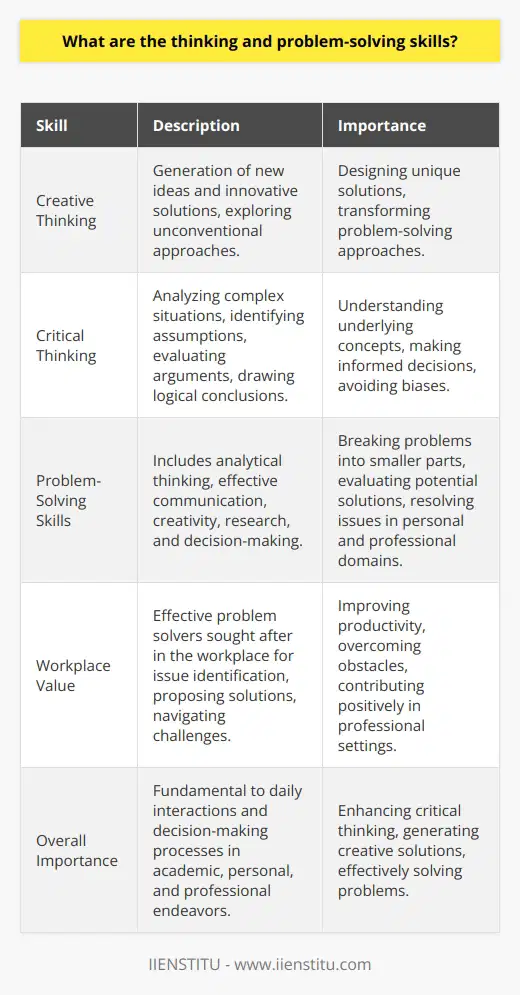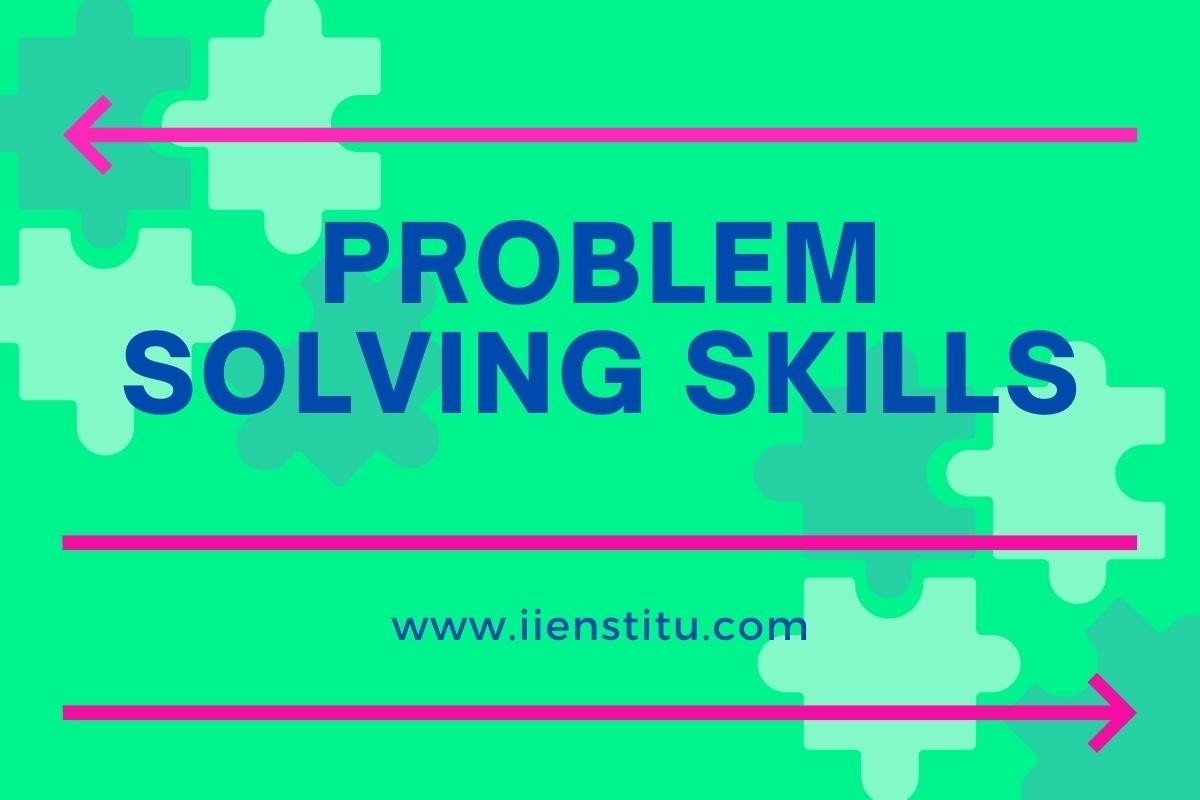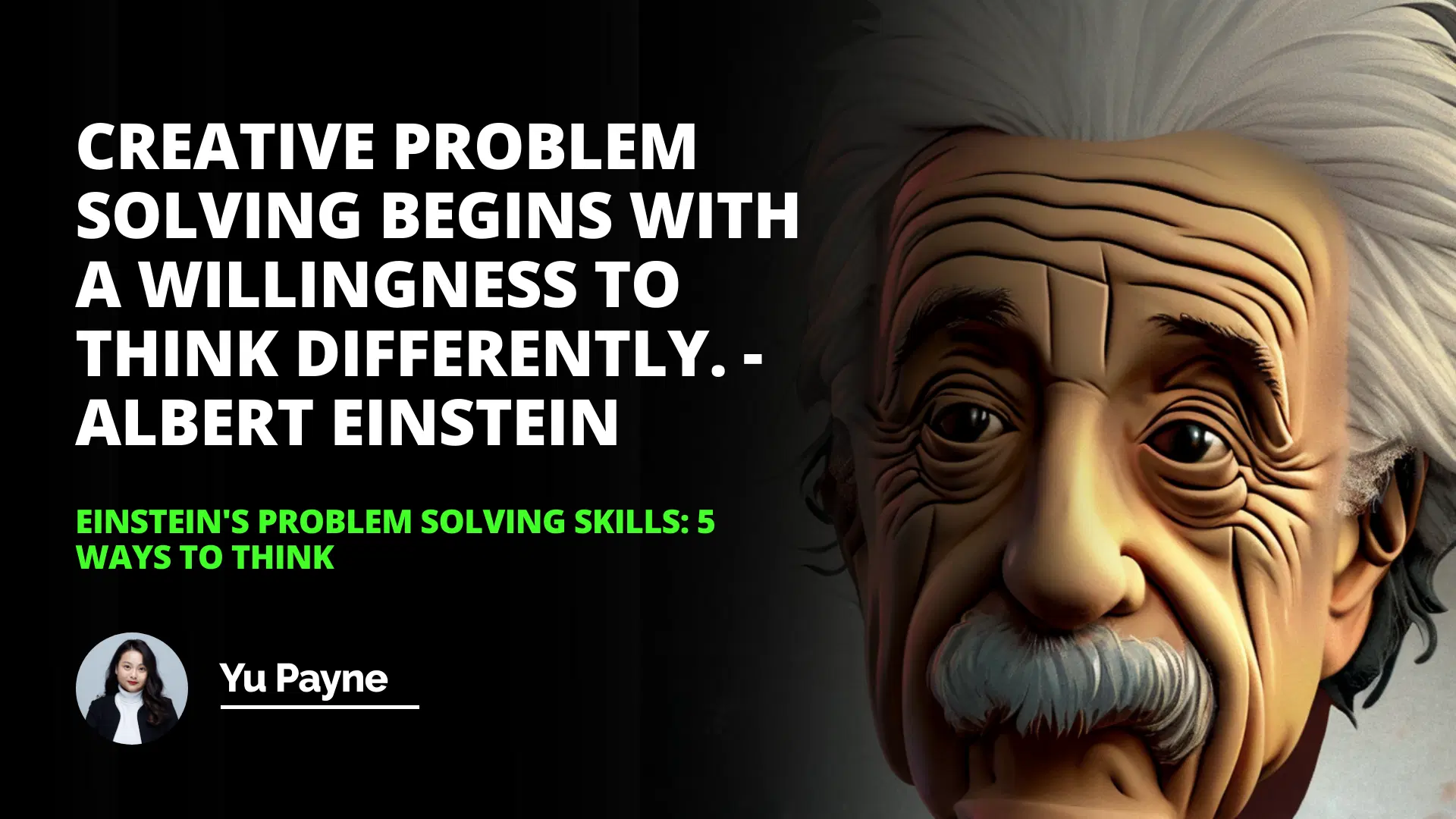
You know, when I was a kid, I was fascinated by the stars. I'd spend hours lying on the grass at night, staring up at the vast expanse of the sky, wondering about the mysteries it held. Little did I know that this curiosity would lead me to a lifelong admiration for one of the greatest minds in history: Albert Einstein. His theories didn't just revolutionize physics; they changed the way we understand the universe. But what always intrigued me more than his scientific achievements was the way he thought. How did Einstein's mind work? What was his secret?
Introduction
Three biographies of Einstein
Five ways he thought
Visualization
Conjuring up a “picture” of the phenomena
Over the years, I've dived into several biographies, trying to piece together the puzzle of his genius. Three books, in particular, stood out: Walter Isaacson's Einstein: His Life and Universe, Abraham Pais's Subtle is the Lord: The Science and the Life of Albert Einstein, and Jürgen Neffe's Einstein: A Biography. Through their pages, I discovered five key strategies that Einstein employed in his thinking: visualization, combinatory play, intuition, imagination, and Gedankenexperiments. As I dug deeper, I realized these weren't just exclusive tools for a genius physicist; they were approaches that anyone, including you and me, could adopt to enhance our own problem-solving skills.
Expert Guide On Statistical Analysis For Strategic Decision Making
Strategic İmpact Of Quality Function Deployment On Product Design
Unveiling the Mind of Einstein: Five Strategies That Shaped a Genius
Visualization: Conjuring Images Beyond Equations
One of the most remarkable aspects of Einstein's thinking was his ability to visualize complex concepts. He didn't rely solely on mathematical equations; instead, he created vivid mental images that allowed him to explore ideas in a more intuitive way.
I vividly remember struggling with a difficult project at my previous job. The data was overwhelming, and no matter how many spreadsheets I analyzed, I couldn't see the solution. Then I thought, "What would Einstein do?" I decided to step away from the numbers and instead drew a flowchart on a big whiteboard, depicting the entire process as a series of interconnected gears. This visual representation helped me identify the bottlenecks and ultimately led to a breakthrough.
In Einstein: His Life and Universe, Isaacson recounts how Einstein imagined himself chasing a beam of light, a thought that sparked his development of special relativity. By picturing the scenario in his mind, he could play with the concept in a way that pure calculation wouldn't allow.
SWOT Analysis Matrix: Comprehensive Guide to Strategic Decision Making
Quality Tools: Essential Techniques for Effective Decision-Making
Jidoka (Autonomation): Introducing Efficiency in Modern Industries
Probability and Impact Matrix: Insightful Guide to Risk Evaluation
But visualization isn't just about seeing; it's about experiencing. Einstein would immerse himself in these mental images, allowing him to "feel" the implications of his ideas. This deep engagement with visualized concepts enabled him to uncover insights that were hidden behind abstract symbols.
Creative problem-solving begins with a willingness to think differently. -Albert Einstein
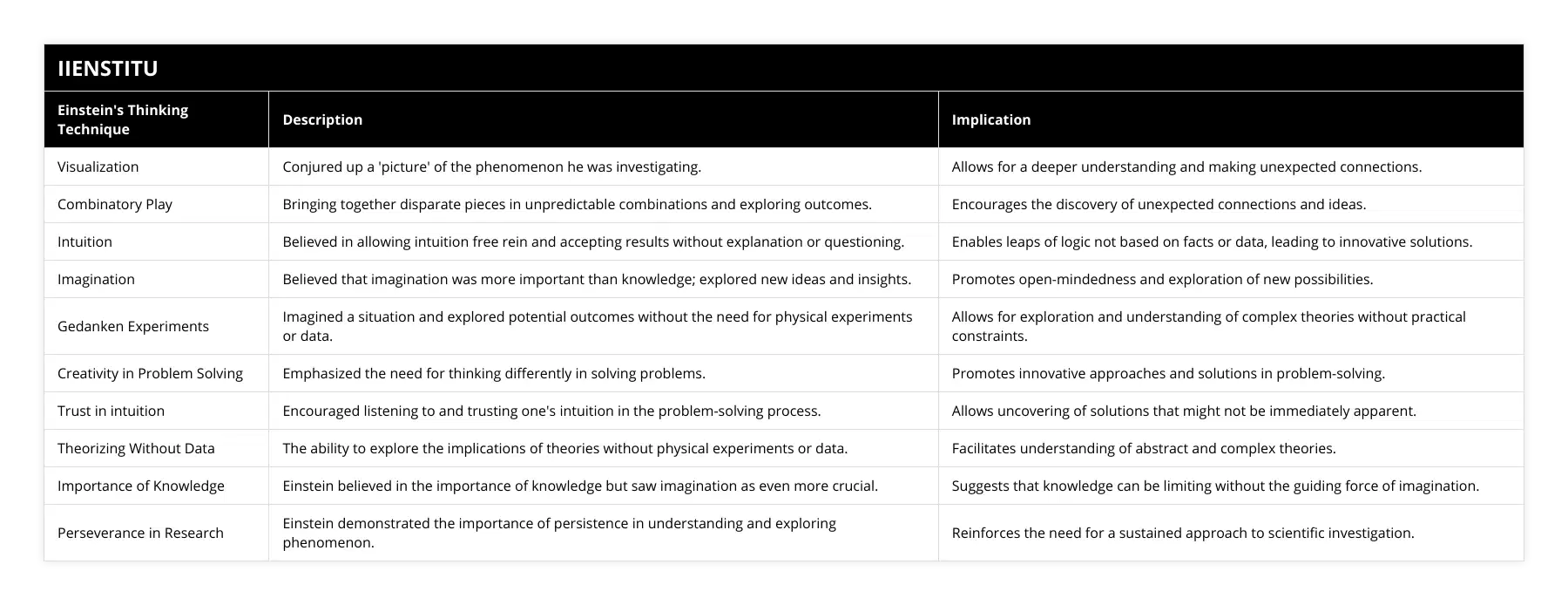
How Visualization Enhances Thinking:
Engages multiple senses, making concepts more memorable.
Simplifies complex ideas by representing them visually.
Encourages creative connections between different elements.
Facilitates communication of ideas to others through visual aids.
Helps identify patterns and relationships that aren't obvious numerically.
Combinatory Play: The Art of Connecting the Unconnected
Einstein had a knack for bringing together seemingly unrelated ideas to spark innovation. This "combinatory play", as he called it, was a cornerstone of his creative process.
I experienced the power of this approach during a team brainstorming session. We were tasked with improving our company's customer service strategy, and frankly, we were hitting a wall. Then someone mentioned their love for gardening, and suddenly, we started comparing customer relationships to nurturing plants. This metaphor opened up new avenues of thinking, and we developed a nurturing program that significantly improved customer satisfaction.
In Subtle is the Lord, Pais describes how Einstein's love for music influenced his scientific thinking. Einstein was an accomplished violinist, and he often drew parallels between musical harmony and the harmony of the cosmos. By blending his passions, he could think about problems in physics with a fresh perspective.
Embracing Combinatory Play:
1- Cross-pollinate ideas from different fields of interest.
2- Break down barriers between disciplines.
3- Encourage interdisciplinary collaboration.
4- Challenge traditional associations and conventions.
5- Foster an environment where unconventional ideas are welcomed.
Intuition: Listening to the Subtle Inner Voice
Einstein placed great trust in his intuition. He believed that logic could only take you so far, and that sometimes, you had to rely on that gut feeling. This doesn't mean abandoning rational thinking, but rather complementing it with an inner sense of direction.
There was a time when I was offered a job that looked perfect on paper. The salary was great, the office was prestigious, but something just didn't feel right. Despite my friends urging me to accept, I listened to my intuition and declined. A few months later, I learned that the company had undergone massive layoffs. Trusting my intuition saved me from what could have been a disastrous move.
In Neffe's biography, he highlights how Einstein's intuition played a critical role in his scientific discoveries. Einstein intuited that time was not absolute, a notion that defied the Newtonian physics of his era. This intuitive leap was pivotal in developing the theory of relativity.
Harnessing Your Intuition:
Take time for reflection to hear your inner voice.
Pay attention to feelings and hunches.
Balance analytical thinking with intuition.
Practice mindfulness to enhance intuitive abilities.
Be open to insights that arise spontaneously.
Imagination: Venturing Beyond the Known
"Imagination is more important than knowledge," Einstein famously said. He understood that to discover something truly new, one must be willing to imagine possibilities beyond current understanding.
In my own career, I've seen how imagination can be a game-changer. While working on developing a new product, we were constrained by what had been done before. It wasn't until we allowed ourselves to brainstorm without limitations – imagining products that seemed impossible – that we stumbled upon a concept that was both innovative and feasible.
Imagination fuels creativity, and creativity leads to innovation. Einstein's willingness to imagine scenarios that defied conventional wisdom enabled him to formulate theories that transformed our comprehension of reality.
<u>Without imagination, progress would remain stagnant.</u>
Nurturing Imagination:
Engage in creative activities like art, music, or writing.
Read widely across different genres and fields.
Allow yourself to daydream without judgment.
Surround yourself with diverse perspectives.
Embrace curiosity and ask "what if" questions.
Gedankenexperiments: Exploring Through Thought
Einstein's thought experiments were perhaps his most distinctive tool. By simulating experiments entirely in his mind, he could explore complex ideas without physical constraints.
One of the most famous examples is his elevator thought experiment. He imagined an observer inside a falling elevator and realized that they wouldn't feel their weight – leading to the principle of equivalence and the insight that gravity and acceleration are indistinguishable.
I tried applying this method when considering the user experience of a new software interface. By mentally walking through the steps a user would take, imagining their reactions and frustrations, I was able to identify usability issues before any code was written.
Implementing Thought Experiments:
1- Clearly define the scenario you wish to explore.
2- Remove unnecessary complexities to focus on key elements.
3- Visualize the process step by step.
4- Consider different variables and outcomes.
5- Reflect on the implications of each scenario.
Applying Einstein's Strategies to Project Management
So how do these strategies relate to today's challenges, like project management or business strategy? Let's consider the critical path method project management strategy, a technique used to identify essential tasks and timelines in a project.
By visualizing the project's workflow, managers can pinpoint the critical path – the sequence of tasks that determines the project's minimum completion time. This is essentially a practical application of visualization and thought experimentation. By imagining how different tasks interrelate, managers can foresee potential bottlenecks and allocate resources effectively.
Moreover, incorporating combinatory play can lead to innovative project solutions. For instance, blending agile methodologies with traditional project management practices might result in a hybrid approach that offers flexibility and structure.
By integrating Einstein's thinking strategies, professionals can enhance their critical thinking in business, improve innovative problem-solving skills, and foster a culture of creativity in the workplace. These methods encourage us to look beyond the obvious and explore transformational leadership approaches that can drive organizations forward.
Personal Reflection
Looking back, I realize that adopting even a fraction of Einstein's thinking processes has enriched my professional and personal life. It has taught me to approach problems with an open mind, to trust my instincts, and to never underestimate the power of imagination.
I've seen colleagues transform their approaches after embracing these methods. One friend, a software engineer, started using thought experiments to debug complex code. Another, a teacher, used visualization to explain abstract concepts to her students, making learning more engaging.
Conclusion
Albert Einstein's legacy extends far beyond his scientific achievements. His unique ways of thinking offer invaluable lessons for all of us. By embracing visualization, combinatory play, intuition, imagination, and thought experiments, we can enhance our creativity, solve problems more effectively, and perhaps, see the world in a whole new light.
So, next time you're stuck on a problem, big or small, why not take a page out of Einstein's book? Visualize the issue, mix in some unexpected ideas, trust your gut, let your imagination run wild, and conduct a thought experiment or two. Who knows what breakthroughs await?
After all, as Einstein wisely said, "The true sign of intelligence is not knowledge but imagination."
References
1- Isaacson, W. (2007). Einstein: His Life and Universe. New York: Simon & Schuster.
2- Pais, A. (1982). Subtle is the Lord: The Science and the Life of Albert Einstein. New York: Oxford University Press.
3- Neffe, J. (2007). Einstein: A Biography. New York: Farrar, Straus and Giroux.
Frequently Asked Questions
What are the five ways Einstein used to think?
Albert Einstein, one of the most renowned physicists of all time, has been credited with numerous scientific breakthroughs, such as the Theory of Relativity. His numerous contributions to science have been documented in various books and articles. However, the methods behind his success remain a mystery. This article will discuss five of how Einstein thought, known as the "Einstein Method."
The first step in the Einstein Method is to think broadly. He was known to be a master of connecting seemingly unrelated concepts and topics, allowing him to make discoveries that otherwise would have been overlooked. He could also transform seemingly mundane ideas into something truly revolutionary.
The second step of the Einstein Method is to question everything. Einstein was a deep thinker and was not afraid to ask difficult questions, even if he didn't have the answers. He could take seemingly simple ideas and ask "why" until he deeply understood the underlying concepts.
The third step of the Einstein Method is to remain persistent and patient. Einstein was willing to take the time to carefully consider and analyze a problem, even if it took him months or years. He was also ready to make mistakes to learn and was not afraid to start from scratch if he was unsatisfied with the results.
The fourth step of the Einstein Method is to think outside the box. He was known to be a master of lateral thinking and was unafraid to consider unconventional theories or ideas. He was also willing to challenge conventional wisdom and accepted views if he believed something more was to be discovered.
The fifth and final step of the Einstein Method is to think deeply. Einstein was known for his ability to go beyond the surface level of a problem and explore the underlying concepts. He was willing to challenge the status quo and look for new solutions to old problems.
In conclusion, Albert Einstein's genius resulted from his ability to think in five distinct ways. He could think broadly, question everything, remain persistent and patient, think outside the box, and think deeply. These five steps of the Einstein Method have been proven time and time again to be highly effective in solving complex problems.
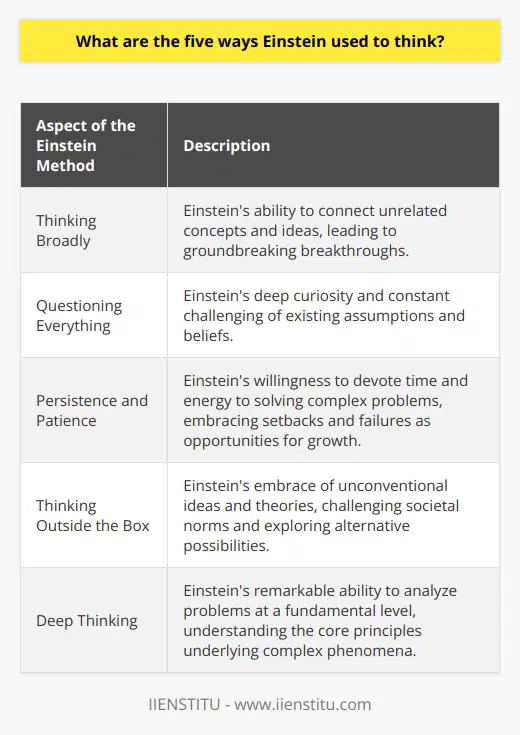
How did Einstein use visualization to solve problems?
Albert Einstein is widely regarded as one of the most brilliant minds of the twentieth century. His theories of relativity and quantum mechanics have been studied and expanded upon by scientists for decades. However, Einstein was not only a brilliant scientist but also an inventor and a master of visualization. He was able to use visualization to help him solve complex problems.
Visualization is a process in which one imagines a problem and visualizes the solution in their head. This allows a person to understand a problem's underlying principles better and come up with creative solutions. Einstein was a master of this technique, which is widely believed to be one of the critical factors that allowed him to develop his revolutionary theories.
One example of how Einstein used visualization to solve a problem can be seen in his work on the theory of special relativity. Einstein applied visualization principles to understand the approach by imagining himself riding on a light beam. This allowed him to conceptualize the idea of time dilation, a critical concept of special relativity.
Einstein also used visualization to help him understand the concept of space-time. To do this, he imagined a four-dimensional world in which time and space were intertwined. This allowed him to visualize the curved nature of space-time and the effects of gravity on it. This visualization permitted Einstein to understand and develop the general theory of relativity.
Einstein also utilized the power of visualization in his work on quantum mechanics. For example, he used visualization to help him understand the wave-particle duality of light and the uncertainty principle. By visualizing these concepts, Einstein was able to gain a better understanding of these complex principles.
Einstein's mastery of visualization was one of the critical factors that allowed him to develop revolutionary theories. His ability to imagine and visualize solutions to complex problems enabled him to see beyond the boundaries of traditional scientific thinking. This is one of the key reasons why he is regarded as one of the greatest scientific minds of all time.
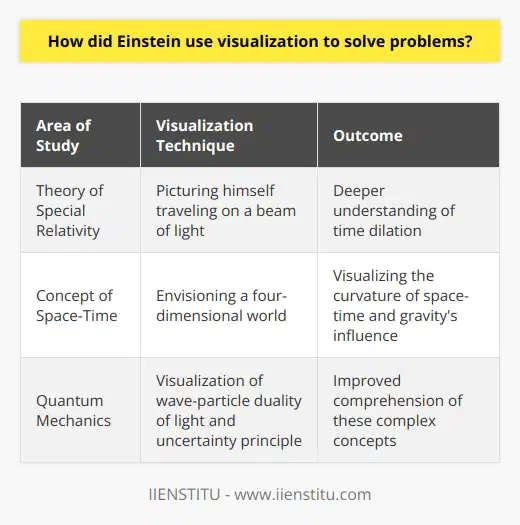
How did Einstein use intuition and imagination to solve problems?
Albert Einstein was one of the most renowned scientists of the 20th century and was famous for his use of intuition and imagination to solve problems. He believed the ability to think imaginatively and intuitively was essential to scientific exploration. He used his intuition and creativity to develop innovative ideas and theories.
Einstein attributed his successes to his creative imagination and intuition. He believed creativity and intuition could be used to develop new theories and solve complex problems. He argued that intuition was an invaluable aid in developing scientific theories, as it allowed him to think outside the box and create ideas that were not constrained by traditional methods of inquiry.
Einstein used his intuition and imagination to develop his Theory of Relativity. First, he observed the motion of light and used his intuition and creativity to formulate an equation describing light's behavior. He then used his intuition to develop a mathematical model to explain light behavior. Einstein's Theory of Relativity revolutionized physics and is still used to describe the universe's behavior today.
Einstein also used his intuition and imagination to develop his Unified Field Theory. First, he used his intuition to identify the fundamental forces that govern the universe. He then used his vision to create a mathematical model that would describe the behavior of these forces.
Einstein's use of intuition and imagination to solve problems was instrumental in his success as a scientist. He believed that intuition and imagination were essential tools for scientific exploration. He used his intuition and imagination to develop new theories and solve complex problems. His use of intuition and imagination to solve problems revolutionized physics and remains an essential tool for scientific exploration today.

What are the five strategies of problem-solving in the context of academic research?
Akademik Araştırmada Problem Çözme Stratejileri
Problemi Tanımlama
Akademik araştırmada problem çözmenin ilk adımı, problemin ne olduğunu açık ve kesin bir şekilde tanımlamaktır. Bu, araştırmanın temel sorusunu ve amacını belirleyerek başlar ve ardından sorunun nedenleri ve etkileri üzerinde odaklanmayı gerektirir.
Bilgi Toplama
Problem çözmeye yönelik bir diğer strateji, sorunun anlaşılması ve çözülmesi için gereken bilgileri toplamaktır. Bu süreç, mevcut literatürü incelemeyi, daha önce yapılmış çalışmalardan ve uzman görüşlerinden yararlanmayı içerir.
Alternatif Çözüm Yolları Geliştirme
Bir sonraki adım, problemi çözmek için farklı çözüm yollarını düşünmek ve değerlendirmektir. Bu, farklı yaklaşımları ve metodolojileri kullanarak, soruna birden fazla açıdan yaklaşmayı ve uygun çözümleri belirlemeyi içerir.
Çözümün Uygulanması
Araştırmada problem çözmenin dördüncü stratejisi, seçilen çözüm yolu üzerinde çalışmaya başlamaktır. Bu süreç, gerekli verileri toplamayı, analiz etmeyi ve sonuçları yorumlamayı içerir.
Değerlendirme ve Revizyon
Son olarak, problem çözme süreci içinde değerlendirmeyi ve revizyonu da içerir. Bu aşamada, çözümün etkili ve uygun olduğuna dair kanıtlar toplanarak, daha ileri araştırma veya uygulama için herhangi bir değişiklik yapılması gerekip gerekmediğini belirlemek önemlidir.
Sonuç olarak, akademik araştırmada problem çözme stratejileri, problemin doğru bir şekilde tanımlanması, bilgi toplanması, alternatif çözüm yollarının geliştirilmesi, çözümün uygulanması ve sonuçların değerlendirilmesi ve gerektiğinde revize edilmesine dayanmaktadır. Bu stratejiler, araştırmacılara, problemleri etkili bir şekilde ele almak ve çözmek için gereken araçları sağlar.

In relation to Einstein's approach to problem-solving, can you explain his perspective on thinking differently to tackle complex issues?
Einstein'ın Problem Çözme Yaklaşımı
Albert Einstein tarafından sıklıkla dile getirilen farklı düşünme anlayışı, problem çözmeye etkileyici ve yenilikçi bir yaklaşım sunar. Einstein, mevcut düşünce kalıplarını ve normları aşarak, karmaşık sorunlara çözüm getirebilecek yaratıcı ve özgün düşüncelere ulaşmanın önemini vurgular.
Karmaşık Sorunlara Farklı Bakış Açısı
Einstein, 'Bir sorunu yaratmak için kullanılan düşünce tarzını kullanarak çözüm bulamazsınız' şeklinde bir yaklaşım benimsemiştir. Bu, mevcut sorunları anlamak ve çözmek için farklı perspektiflerden, disiplinlerarası bilgi ve yöntemlerle yaklaşmak gerektiği anlamına gelir.
Yaratıcılığın Rolü
Einstein, yaratıcılığın bilim ve problem çözmedeki önemine inanıyor ve kendi başarılarında bu özelliğin büyük rolü olduğunu dile getiriyordu. Yaratıcılık ve hayal gücünün, bilimsel keşiflerin ve yeni fikirlerin birincil kaynağı olduğunu savunuyordu.
Aşamalı Düşünme Metodu
Einstein'ın problem çözme yöntemine göre, karmaşık sorunların üstesinden gelmek için aşamalı bir düşünme süreci benimsemek gereklidir. Farklı düşünme aşamaları, bilinmeyenlere odaklanmak ve problemi daha geniş ve bütünsel bir çerçevede görüp analiz etmeyi içerir.
Deneyerek Öğrenme
Einstein, bilgiyi deneyim yoluyla elde etme anlayışına sahipti. Yeni fikirler ve çözümler üretmek için yalnızca teorik bilgiden değil, öğrenmek ve yenilikleri deneyerek hedefe ulaşma sürecinin önemini vurguladı.
Sonuç olarak, Einstein'ın problem çözme yaklaşımı, karmaşık konuları ele alırken farklı düşünme, yaratıcılık, aşamalı düşünme ve deneyimle öğrenme yöntemleri sayesinde başarılı sonuçlar elde etmeyi önerir. Bu yaklaşım, günümüz dünyasında bilgi patlaması ve değişen paradigmalarla birlikte düşünme ve problem çözme becerilerinin geliştirilmesinde hâlâ büyük öneme sahiptir.

How does adopting a problem-solving mindset contribute to better understanding and resolving challenges in various academic disciplines?
Sorun Çözme Odaklı Zihniyetin Önemi
Farklı akademik disiplinlerdeki zorlukları anlamak ve çözmek için sorun çözme odaklı bir zihniyet benimsemek, önemli ölçüde katkıda bulunur. Bu zihniyet, öğrencilerin bulundukları alanın karmaşıklığını ve değişkenlerini daha iyi kavramalarını sağlar.
Analitik Düşünce Geliştirme
Sorun çözme odaklı düşünce, analitik düşünme becerilerini geliştirir. Bu sayede, öğrenciler problemleri daha kapsamlı olarak değerlendirebilir ve her durum için en uygun stratejileri belirleyebilirler.
Yaratıcı Yaklaşımların Teşvik Edilmesi
Sorun çözmeye yönelik zihniyet, yaratıcılığı ve yenilikçi düşünceyi teşvik eder. Çeşitli akademik disiplinlerde yeni ve etkili yöntemlerin keşfi için yaratıcı yaklaşımların kullanılması önemlidir.
Etkili İşbirliği ve İletişim
Sorun çözme becerisinin benimsenmesi, etkili işbirliği ve iletişim ihtiyacını ortaya koyar. Farklı disiplinlerdeki zorlukların üstesinden gelmek için takım çalışması ve açık iletişim önem taşır.
Esneklik ve Uyum Kabiliyeti
Sorun çözme odaklı zihniyet, öğrencilere esneklik ve uyum yetisi kazandırır. Bu özellikler, farklı akademik disiplinlerde karşılaşılan zorluklarla baş etme becerisini artırır.
Sonuç olarak, sorun çözme odaklı bir zihniyet benimsemek, çeşitli akademik disiplinlerde karşılaşılan zorlukların üstesinden gelmek için önemli bir adımdır. Bu zihniyet, analitik düşünce, yaratıcılık, işbirliği ve esneklik gibi becerilerin geliştirilmesine olanak tanır. Bu sayede, öğrenciler başarılı çalışmalar yürütebilir ve alanlarında öncü olabilirler.
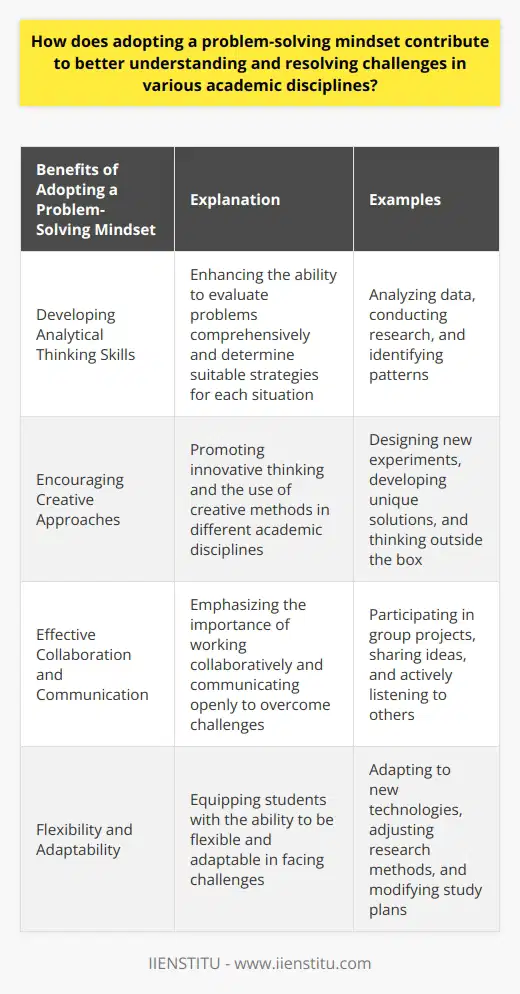
What are the key elements of Einstein's problem-solving philosophy, and how can they be applied in contemporary academic research?
**Einstein's Problem-Solving Philosophy**
Einstein's problem-solving philosophy entails three crucial elements: a sense of curiosity, development of thought experiments, and engagement with the scientific community. The integration of these components in contemporary academic research can yield significant advancements and insights.
**Curiosity-Driven Approach**
Firstly, fostering a sense of curiosity is pivotal to Einstein's problem-solving approach. For Einstein, the desire to comprehend the natural world and unveil its underlying principles was a driving force behind his scientific inquiries. In the present academic landscape, embracing this spirit of curiosity encourages researchers to push boundaries, ask thought-provoking questions, and seek novel perspectives that enable breakthrough discoveries.
**Thought Experiments**
Secondly, Einstein emphasized the use of thought experiments, or Gedankenexperimente, to mentally simulate the implications of hypotheses and assumptions. This practice helps researchers to examine hypothetical scenarios, discern flaws in their underlying logic, and refine their approach accordingly. For example, imagine a researcher examining the impact of a stimulus on a group of individuals. By contemplating how different stimulus levels might exaggerate or negate the reaction, the researcher can craft a more robust experimental design. Thus, thought experiments provide a valuable tool for enhancing the soundness and intellectual merit of contemporary academic research.
**Engagement with the Scientific Community**
Lastly, Einstein's problem-solving philosophy highlights the importance of engaging with a diverse and intellectually rigorous scientific community. Einstein relied on the exchange of ideas, debate, and collaboration with other scientists to refine his theories and challenge prevailing paradigms. In the context of modern academic research, researchers can apply this principle by actively participating in conferences, workshops, and collaborative projects that stimulate cross-disciplinary discourse and foster innovative thinking.
**Conclusion**
In conclusion, Einstein's problem-solving philosophy - defined by curiosity, thought experiments, and engagement with the scientific community - can provide a robust foundation for optimizing contemporary academic research endeavors. By adopting these core components, researchers can stimulate innovation, refine their methodology, and facilitate advancements in the pursuit of knowledge.
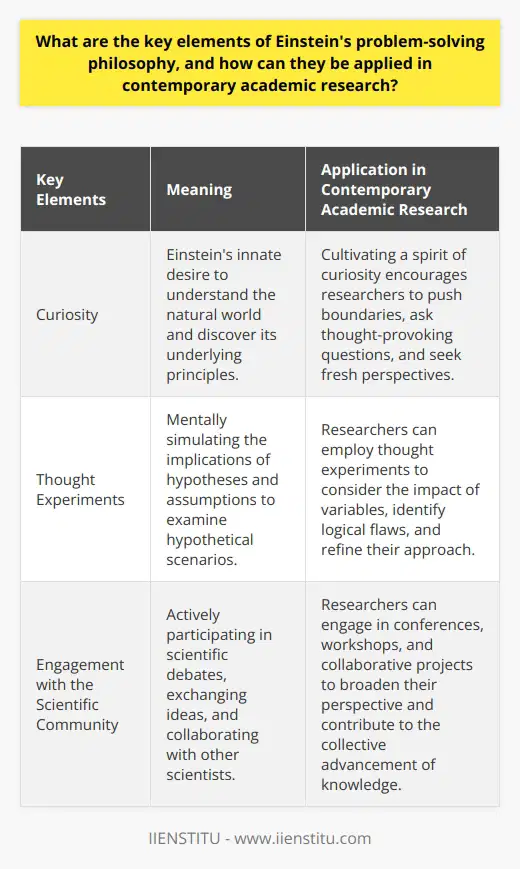
How does incorporating the problem-solving way of thinking, as exemplified by Einstein, enhance the process of addressing and navigating complex issues in various fields of study?
Embracing Einstein's Approach
Incorporating the problem-solving perspective, which Einstein famously exemplified, offers significant benefits when addressing and navigating multifaceted issues spanning diverse fields of study. Einstein's method focuses on understanding the root of a problem, breaking it down into manageable components, and testing hypotheses through experimentation. Adopting this mindset enables individuals to better comprehend and manage intricate problems, leading to innovative and adaptable solutions.
Critical Analysis of Issues
A vital aspect of Einstein's approach lies in his reliance on critical analysis. He believed that the key to tackling difficult problems is to think deeply about the fundamental principles involved. By emphasizing such analysis, students and professionals alike can develop a solid conceptual foundation. This understanding allows for more effective communication, as individuals can address underlying key factors contributing to a situation or problem.
Breaking Down Complexities
Another element of Einstein's method involves breaking down complex problems into smaller, manageable parts. This technique encourages focusing on each subproblem individually, simplifying the task and promoting a sense of cognitive clarity. Consequently, abstract issues become increasingly tangible, which facilitates informed decision-making based on clear evidence, rather than relying on intuition or guesswork.
Experimentation and Hypothesis Testing
Einstein's commitment to experimentation and hypothesis testing is essential. These processes can provide tangible evidence to support or refute an idea, thereby strengthening the basis for decision-making. The ability to test ideas methodically ensures that solutions are both creative and empirically grounded. This approach also fosters a culture of continuous learning, as individuals can learn from errors or misconceptions to refine their understanding of complex issues.
Applicability in Various Fields
The versatility of the problem-solving approach makes it well-suited for application across diverse areas of study. From science and engineering to business and social sciences, the skills developed through Einstein's methods enhance practitioners' abilities to analyze and navigate intricate problems. This promotes innovative thinking, heightens adaptability, and ultimately leads to more sustainable and effective solutions.
In conclusion, integrating Einstein's problem-solving way of thinking into various fields of study enriches the process of addressing and navigating complex issues. This approach emphasizes critical analysis, simplification of complexities, and experimentation, improving decision-making and fostering learning. By cultivating such skills, professionals and students can develop innovative, adaptable solutions to the multifaceted challenges that arise across disciplines.
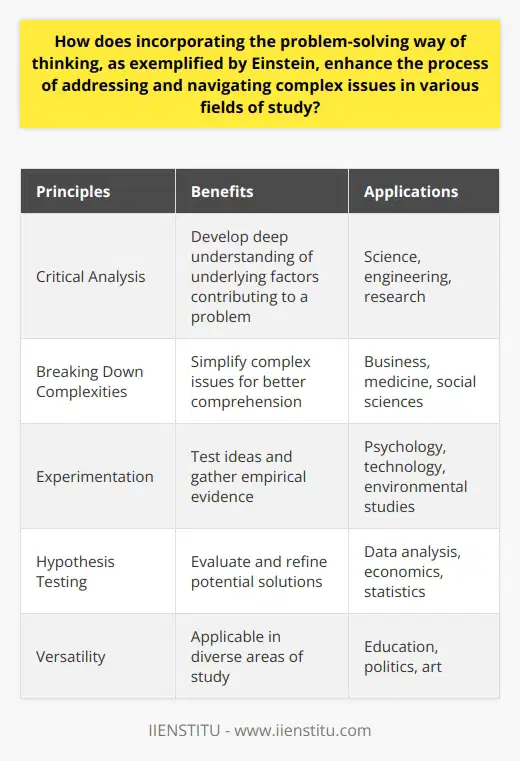
In light of Einstein's famous quote on problem-solving and thinking differently, what strategies can be employed to foster a more innovative and effective approach to tackling academic challenges?
**Einstein's Insight on Problem-Solving**
Einstein's renowned quote, 'We cannot solve our problems with the same thinking we used when we created them,' suggests a strong need for adopting novel and innovative approaches to address academic challenges. A shift in mindset is crucial to overcoming obstacles and generating original solutions.
**Encourage Creative Thinking**
One strategy to cultivate innovation comprises fostering a learning environment that encourages creative thinking. By offering opportunities for brainstorming, active discussion, and open-minded questioning, educators can stimulate students to think differently and collaboratively, producing new insights and ideas.
**Embrace Diverse Perspectives**
Incorporating diverse perspectives is vital to cultivating an effective approach. By bringing together students from differing backgrounds, experiences, and cultures, inventive ideas can emerge. This fusion of viewpoints can spark fresh ideas and challenge established beliefs, promoting innovation.
**Promote a Growth Mindset**
Adopting a growth mindset is another essential strategy for tackling academic challenges. By emphasizing the importance of grit, perseverance, and flexibility, students become inspired to address problems from different angles, rather than giving up at the first sign of difficulty. With this mindset, failure is perceived as an opportunity for learning and growth, thereby fostering a generation of resilient, innovative problem-solvers.
**Integrate Cross-disciplinary Approaches**
Lastly, integrating cross-disciplinary approaches to problem-solving can result in more effective innovations. By combining techniques and knowledge from different fields, unexpected solutions may arise. The synthesis of ideas from various academic areas can provide an enriched perspective, fortifying a student's ability to tackle complex challenges.
In conclusion, fostering innovation to tackle academic challenges must involve nurturing creative thinking, embracing diverse perspectives, adopting a growth mindset, and integrating cross-disciplinary approaches. By nurturing these qualities, we can instill a sense of curiosity, resilience, and adaptability in students, empowering them to approach challenges with fresh thinking, as Einstein advocated.

What are the primary characteristics of a problem-solving way of thinking, and how can this mindset be cultivated within academic fields?
Key Characteristics of Problem-Solving Thinking
The primary characteristics of a problem-solving way of thinking include analytical skills, critical thinking, creativity, adaptability, and perseverance. These traits facilitate the identification and analysis of issues, the generation of innovative solutions, and the tenacious pursuit of success despite challenges.
Developing Analytical Skills and Critical Thinking
One crucial aspect of cultivating a problem-solving mindset is developing analytical skills and critical thinking. This includes evaluating information with a discerning eye, recognizing patterns and trends, and taking a systematic approach to solving problems. Students can improve these skills by engaging in debates, workshops, and discussions that require them to scrutinize complex and ambiguous concepts.
Encouraging Creativity
Another important element in fostering a problem-solving mindset is encouraging creativity. Students should be allowed to experiment with various strategies and ideas to find unique, innovative ways to address challenges. By providing a supportive environment where risk-taking and failures are accepted as valuable learning opportunities, educational institutions can help students build the confidence that enables successful problem-solving.
Promoting Adaptability
Problem-solvers must also possess adaptability, enabling the ability to acknowledge when an approach is ineffective and to revise strategies accordingly. Faculty can help nurture this skill by assigning projects that require flexibility and dynamism, such as interdisciplinary studies, group work, or assignments involving real-world situations that present unanticipated complications.
Cultivating Perseverance
Lastly, perseverance is a key ingredient to a problem-solving mindset. This trait motivates individuals to pursue resolutions to issues relentlessly despite setbacks and difficulties. Educators can instill this characteristic by providing a challenging academic environment where resilience is necessitated in overcoming obstacles.
Integrating Problem-Solving into Academic Fields
To successfully cultivate a problem-solving mindset within academic fields, educational institutions must incorporate these key characteristics into their curricula and teaching methodologies. By offering opportunities for the development of analytical skills, critical thinking, creativity, adaptability, and perseverance, academic institutions create well-rounded, capable problem-solvers that thrive in any context.
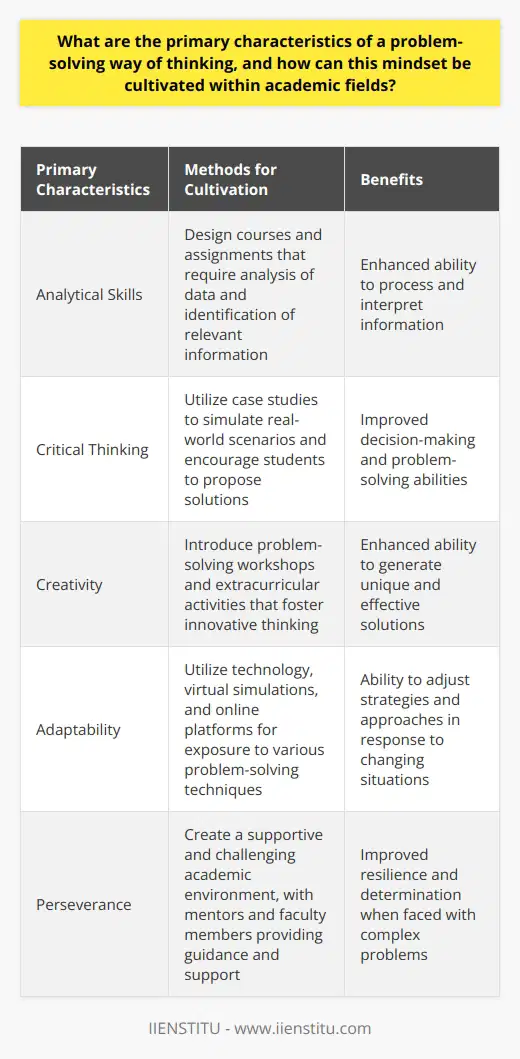
How does Einstein's perspective on problem-solving and the necessity of distinct thinking approaches contribute to our understanding of complex issues across various disciplines?
Einstein's Perspective on Problem-Solving
Einstein's perspective on problem-solving involves approaching challenges with creativity and flexibility, emphasizing the importance of distinct thinking methods. This view is instrumental in helping us understand and navigate complex issues across diverse fields.
Necessity of Distinct Thinking Approaches
Einstein's perspective on problem-solving highlights the need for different thinking approaches to tackle complex issues, leading to better outcomes. By encouraging us to think beyond conventional wisdom, it contributes significantly to our ability to solve problems in various disciplines.
Cross-Disciplinary Applications
Einstein's ideas can be applied to multiple disciplines, giving them the flexibility to address complex issues by adopting innovative thinking processes. For example, in science, these principles can help us break through barriers, develop new technologies, and propel research forward. In the realm of economics, they can foster creative solutions to financial challenges or resource scarcity. Furthermore, in social science, they can lead to better understanding and resolution of societal conflicts.
Promoting Critical Thinking
Einstein's perspective on problem-solving promotes critical thinking and the development of analytical skills needed to grasp complex concepts. This emphasis on critical thinking is vital to mastering multidimensional issues faced in diverse fields. It inspires curiosity, fostering a spirit of inquiry and encouraging individuals to probe deeper into topics, leading to a more in-depth understanding of the subject matter.
Encouraging Collaboration
Using distinct thinking approaches also necessitates collaboration, as it encourages experts from different fields to work together towards solving complex problems. Einstein's perspective supports interdisciplinary collaboration, which combines insights from various subject areas, leading to more comprehensive solutions.
In conclusion, Einstein's perspective on problem-solving and the need for distinct thinking approaches significantly contribute to our understanding of complex issues across various disciplines. By promoting flexibility, creativity, critical thinking, and collaboration, it creates space for us to develop innovative solutions to the challenges faced in today's rapidly evolving world.
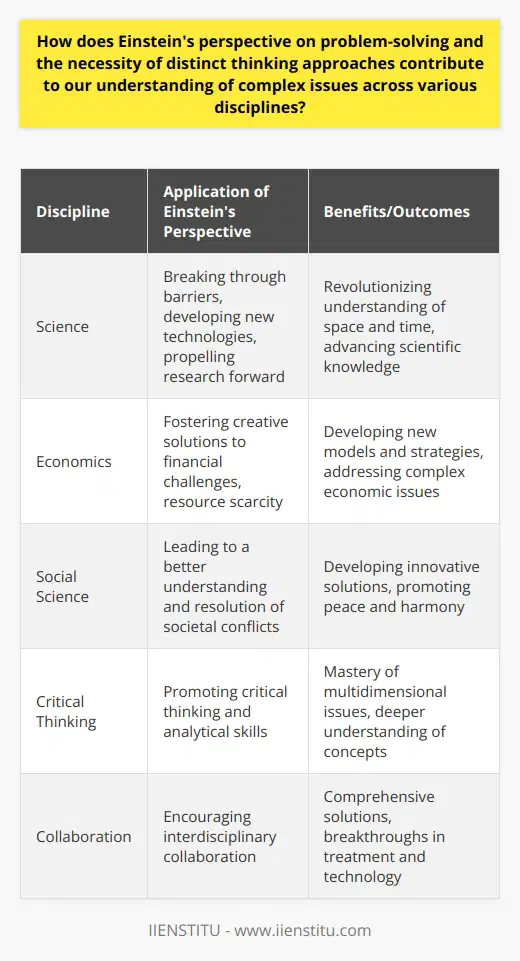
In the context of Einstein's problem-solving philosophies, how can researchers and academics create an environment conducive to fostering innovative solutions and novel approaches?
Embracing Curiosity and Open-mindedness
In line with Einstein's problem-solving philosophies, researchers and academics can foster an environment conducive to innovative solutions by embracing curiosity and promoting open-mindedness. Einstein believed that curiosity driven investigations led to great achievements, stating that 'the important thing is not to stop questioning.' Therefore, cultivating an atmosphere where questions are encouraged, welcomed, and valued can empower individuals to challenge conventional wisdom and search for novel approaches.
Adopting a Multidisciplinary Approach
To foster innovation within academia's confines, it is essential to promote cross-disciplinary collaborations and non-linear thinking. Einstein's success in understanding the universe's complexities hinged on his ability to draw from various disciplines, merging physics, mathematics, and philosophy. By encouraging researchers to adopt a multidisciplinary approach, academics can higher the probability of transcending traditional boundaries and igniting the intellectual curiosity needed for groundbreaking discoveries.
Creating a Supportive Community
Developing a community that supports and nurtures creative thinking is crucial to cultivating innovative environments. Einstein famously said, 'Anyone who has never made a mistake has never tried anything new.' As such, researchers and academics must create spaces where individuals can take risks without fear of failure, knowing that their peers and mentors are behind them. Recognizing that failures can lead to valuable learning experiences, such environments can foster a growth mindset and resilience, truly enabling novel ideas to flourish.
Prioritizing Diversity and Inclusivity
Lastly, nurturing a culture of inclusivity and diversity is paramount to generating innovative solutions. As Einstein emphasized, 'we cannot solve our problems with the same thinking we used when we created them.' By embracing individuals from diverse backgrounds and perspectives, academia can overcome the limitations of insular thinking and access a rich array of ideas, contributing to the generation of pioneering concepts and approaches.
In conclusion, fostering innovative solutions and novel approaches within academia aligned with Einstein's problem-solving philosophies involves encouraging curiosity, adopting multidisciplinary thinking, creating supportive communities, and prioritizing diversity and inclusivity. Through these principles, researchers and academics can create environments that spur groundbreaking discoveries, thus advancing human knowledge and understanding.
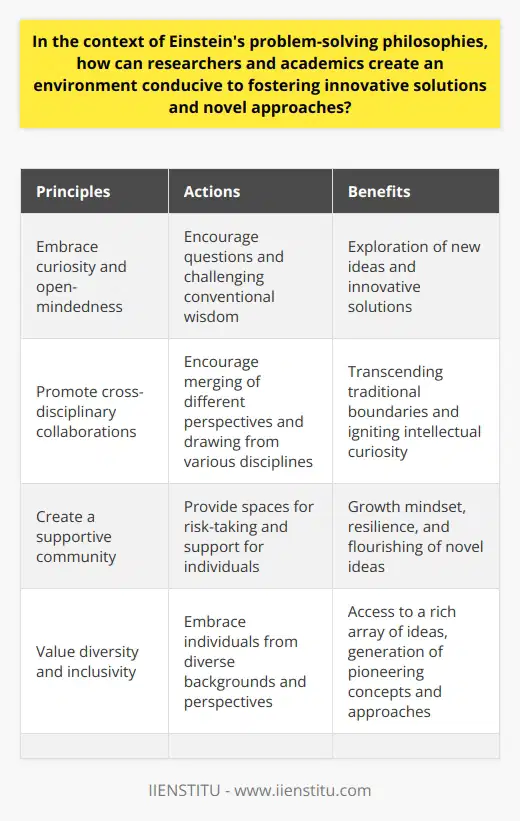
What are the core principles of a problem-solving way of thinking, and how can they be implemented in academic research methodologies?
Core Principles of Problem-Solving Thinking
The core principles of a problem-solving way of thinking encompass understanding the problem, devising a plan, implementing the solution, and evaluating the results. Integrating these principles into academic research methodologies enhances the research process by promoting clarity, offering direction, and enabling researchers to ensure the validity of their findings.
Understanding the Problem
In academic research, understanding the problem involves clearly defining the research question or hypothesis, specifying the objectives, and identifying the desired outcomes. This step is crucial as it allows researchers to gain a comprehensive understanding of the issue at hand, enabling them to make well-informed decisions throughout the research process.
Devising a Plan
Devising a plan requires the researcher to outline a systematic approach to collecting and analyzing data. They must decide on the research design, select appropriate data collection methods, and establish the sampling technique. By creating a detailed and structured plan, researchers ensure that they are equipped to address the research question effectively.
Implementing the Solution
Carrying out the planned research activities is crucial for generating empirical evidence to support or refute the research hypothesis. This phase involves data collection, data analysis, and interpretation of results. Researchers must adhere to ethical guidelines and maintain objectivity, ensuring the validity and reliability of their findings.
Evaluating the Results
The final step in the problem-solving way of thinking is evaluating the results. Researchers must draw conclusions based on the findings, discuss the implications of the results, and consider limitations and potential areas for further inquiry. This process allows researchers to assess the impact of their work and identify possible improvements for future iterations of their research.
Implementing Problem-Solving Thinking in Academic Research
Incorporating problem-solving thinking into academic research methodologies bolsters the quality of research by providing a structured, systematic, and ethical approach to addressing complex issues. By fostering a deeper understanding of the problem, devising a solid plan, implementing the solution, and evaluating the results, researchers can cultivate a rigorous and robust research process.
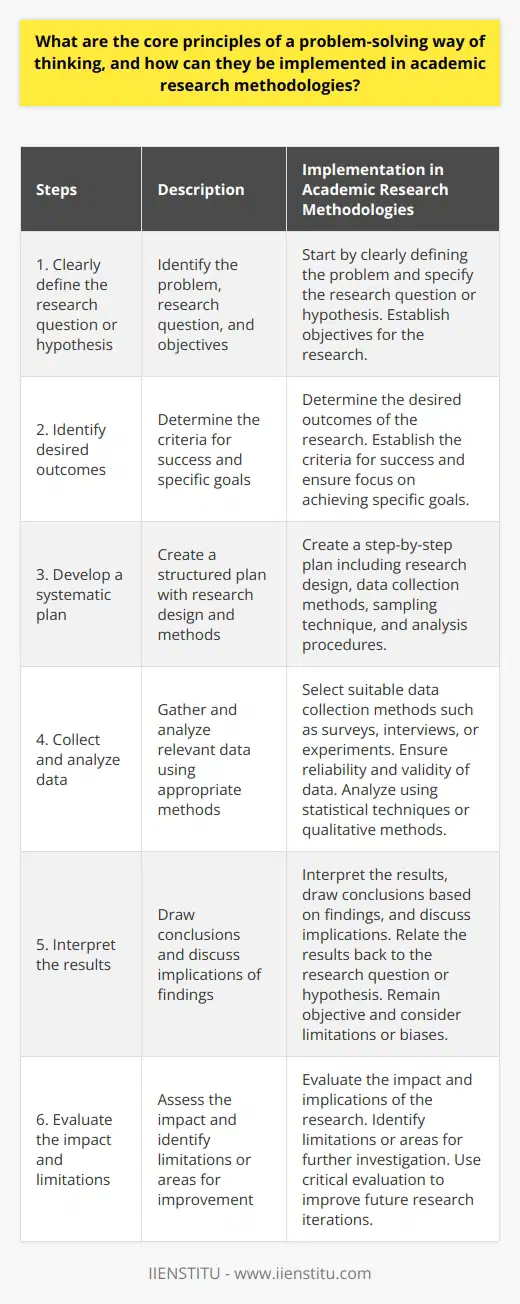
How did Einstein's perspective on problem-solving influence the development of his groundbreaking theories, and what insights can be gleaned for contemporary researchers?
Einstein's Problem-Solving Process
Albert Einstein's innovative problem-solving approach played a pivotal role in shaping his groundbreaking theories, which subsequently transformed the landscape of modern physics. His exceptional methodology offers valuable insights for contemporary researchers, encouraging them to think beyond the conventional boundaries and embrace the power of imagination.
Embracing Thought Experiments
Remarkably, Einstein relied on thought experiments, where he envisioned hypothetical situations that helped him develop an intuitive understanding of abstract concepts. These mental explorations allowed him to refine his ideas before undertaking a mathematical formulation, as seen in his development of the General Theory of Relativity. Carrying out such thought experiments, contemporary researchers can stimulate creativity and gain new insights into complex issues.
The Role of Intuition
Einstein strongly believed in the power of intuition, which guided him in formulating and testing his theories. He once stated, 'There is no logical way to the discovery of the essential nature of the world. There is only the way of intuition.' This emphasis on intuitive thinking encourages contemporary researchers to trust their instincts and engage in hunch-driven exploration, which leads to groundbreaking discoveries.
Overcoming Preconceived Notions
A significant aspect of Einstein's problem-solving approach was his ability to question and dismantle pre-existing beliefs about the physical world. He challenged the long-held assumption that space and time were fixed entities, proposing the radical idea of space-time curvature in his General Theory of Relativity. Such tenacity in questioning established norms provides a valuable lesson for contemporary researchers to challenge the status quo and seek scientific advancement.
Adopting an Interdisciplinary Approach
Einstein's remarkable range of interests spanned across diverse fields, including philosophy, politics, and music. His exposure to different disciplines allowed him to synthesize ideas and view problems from multiple perspectives, contributing to his scientific breakthroughs. Contemporary researchers can benefit from adopting an interdisciplinary approach to problem-solving, fostering innovative thinking patterns and tapping into previously untapped sources of knowledge.
In conclusion, Einstein's problem-solving approach embodies the essence of innovative thinking within the scientific realm. By embracing thought experiments, valuing intuition, questioning pre-existing beliefs, and fostering interdisciplinary thinking, contemporary researchers can make significant strides in their quest for knowledge and the development of novel theories.
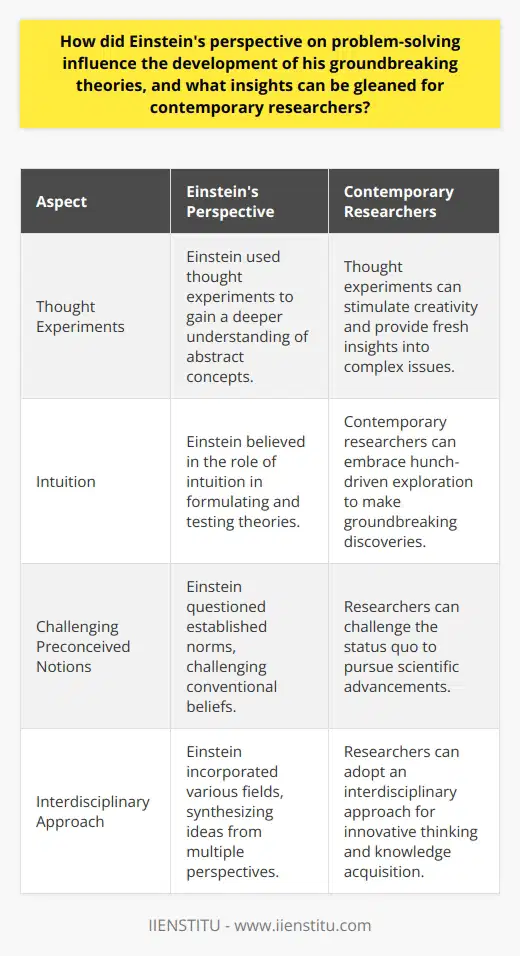
In the context of Einstein's belief that we cannot solve problems with the same thinking that created them, what are some strategies for cultivating a transformative mindset in academic research and problem-solving?
Redefining the Inquiry Process
One crucial strategy for cultivating a transformative mindset in academic research and problem-solving is redefining the inquiry process. Researchers ought to employ intellectual curiosity and reflexivity in order to question pre-existing assumptions, design innovative research questions, and pursue alternative research methods. This allows scholars to critically evaluate their own work, as well as that of others, creating more effective and inclusive academic practices.
Embracing Interdisciplinarity
Another essential approach to fostering transformative thinking in academia is embracing interdisciplinarity. By actively seeking connections and collaborations across various disciplines, researchers gain a broader contextual understanding of their subject matter. Drawing on insights and methodologies from multiple fields exposes academics to diverse perspectives, fostering creative and innovative solutions to critical problems.
Encouraging Divergent Thinking
Promoting divergent thinking is an essential step for cultivating a transformative mindset. Divergent thinking involves considering multiple possibilities and solutions to complex issues simultaneously. Encouraging this approach in academic research and problem-solving fosters a willingness to take risks, tolerate ambiguity, and tolerate uncertainty. Developing these individual attributes is essential for approaching challenges with an open mind, embracing novel ideas, and transcending traditional thought paradigms.
Contextualizing Knowledge Production
To cultivate a transformative mindset, academics must recognize the need for contextualizing knowledge production. Acknowledging the social, political, and historical contexts within which research is conducted enables researchers to challenge dominant paradigms and open doors for alternative interpretations. Additionally, contextualizing knowledge production contributes to tackling global issues by foregrounding the role of diverse thinkers and their respective cultural contributions.
Adopting an Experiential Learning Approach
Lastly, adopting an experiential learning approach in academic research and problem-solving is crucial for fostering transformative mentalities. Experiential learning emphasizes direct, hands-on experiences and practical applications, allowing researchers to challenge their worldviews and foster personal growth. Implementing this strategy enables individuals to actively build, evaluate and modify their assumptions and beliefs, leading to transformative learning experiences.
In conclusion, cultivating a transformative mindset in academic research and problem-solving requires multiple shifts in thinking and practice. By redefining the inquiry process, embracing interdisciplinarity, encouraging divergent thinking, contextualizing knowledge production, and adopting an experiential learning approach, researchers can transcend traditional thought patterns and create innovative solutions that align with Einstein's belief in thinking differently to solve complex problems.
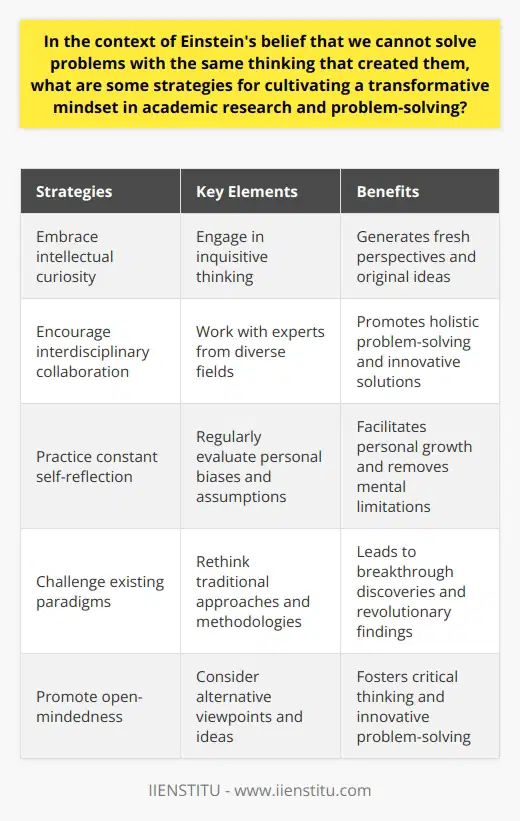
What are the five ways of developing problem-solving skills?
Developing Deep Understanding
The development of problem-solving skills starts by having a deep understanding of a problem. This involves identifying the problem and considering its root causes. Use critical thinking skills to dissect complex problems. Consider assumptions, evaluate arguments, and understand logical connections between ideas.
Practicing Diligence
Secondly, practice diligence in addressing problems. Patience and perseverance play vital roles in problem-solving. The willingness to revise and refine your work significantly improves problem-solving skills. Effort could make the difference between successful conclusions and incomplete solutions.
Adopting a Systematic Approach
Thirdly, adopt a systematic approach when solving problems. Systems help to create order and structure. They support the meticulous examination of different solutions and their impacts. It is essential to explore all possible solutions while designing optimum outcomes.
Incorporating Creative Thinking
Fourthly, incorporate creative thinking into your problem-solving toolkit. Unconventional thinking opens the door to innovative solutions. It facilitates the brainstorming process, generating novel ideas and abstract concepts. Remember: thinking outside the box often uncovers optimal solutions.
Learning from Mistakes
Lastly, embrace mistakes as learning opportunities. Reflect upon failures and strive to understand what went wrong. This process enhances decision-making abilities, enriches knowledge, and builds resilience. Continuous learning remains vital for improving problem-solving skills.
In closing, developing problem-solving skills involves deep understanding, practicing diligence, adopting a systematic approach, incorporating creative thinking, and learning from mistakes. These strategies foster resilience, innovation, and efficiency in problem-solving.
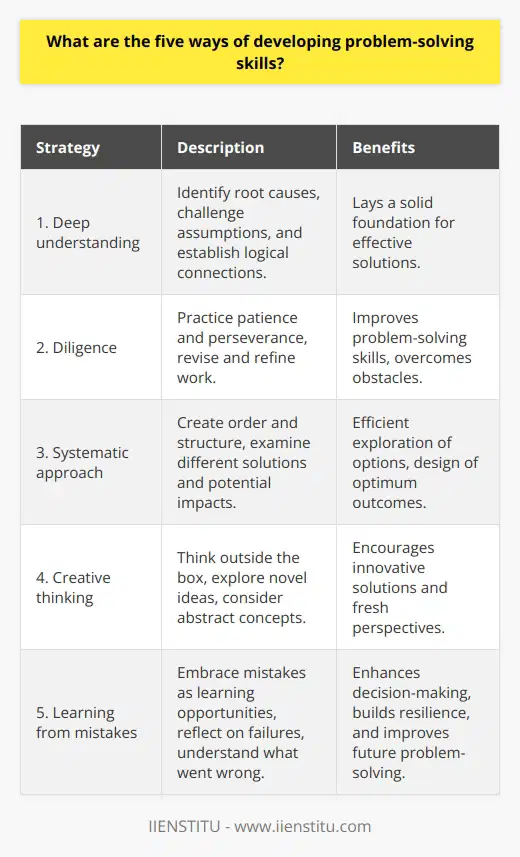
Did Einstein say we can't solve problems by using the same kind of thinking we used when we created them?
Interpreting Einstein's View
A widely attributed quote to Einstein says that we cannot solve problems by using the same kind of thinking we used when we created them. However, despite its popularity, no documented evidence exists that the scientist actually verbalized or wrote this statement.
Examining Its Authenticity
While numerous online platforms and motivational speakers commonly attribute this quote to Einstein, no primary sources corroborate its authenticity. Several quote databases and collections of Einstein’s writings and speeches do not include this sentence.
Possible Misinterpretation
It is plausible that the statement is a misinterpretation or a paraphrase of Einstein’s actual beliefs. Einstein did emphasize the importance of innovative thinking and radical approaches to scientific breakthroughs in numerous instances throughout his career.
Exploration of Similar Quotes
Quotations with similar sentiments can be found in Einstein’s documented statements. For example, he once said, 'The true sign of intelligence is not knowledge but imagination.' This quote reflects the same underlying principle of seeking novel approaches to problems.
Conclusion: Einsteins Perspective
In conclusion, while Einstein might not have said the exact words, it is clear that he advocated for innovative thinking to solve complex problems. By embracing change and fostering curiosity, we can challenge pre-existing systems and ideologies to create effective solutions.
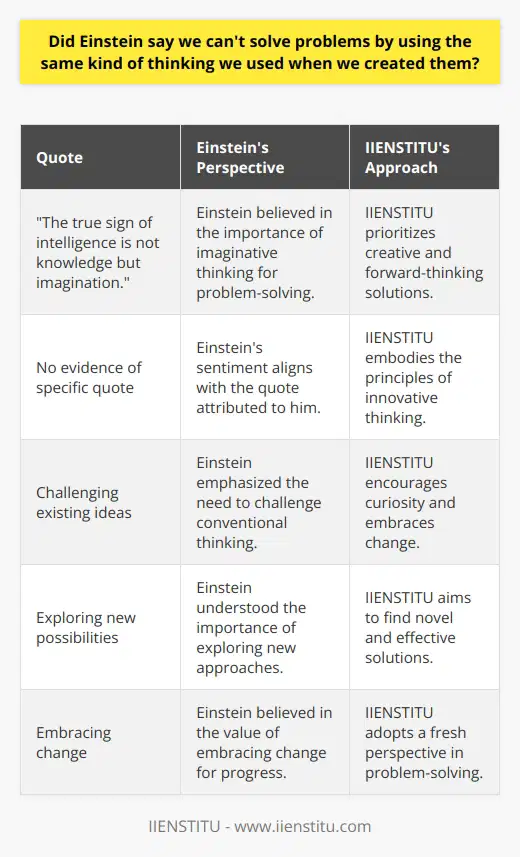
What are the thinking and problem-solving skills?
Understanding Thinking and Problem-Solving Skills
Thinking skills denote our mental abilities to reason, make decisions, and create fresh ideas. Critical thinking involves analysing and critically evaluating information while creative thinking refers to generating innovative solutions.
Role of Creative Thinking
Creative thinking employs our imagination to formulate new concepts. It's pivotal in designing unique solutions to complex problems. These skills aid us in perceiving situations from varied perspectives and exploring innovative approaches.
Importance of Critical Thinking
Critical thinking is the process of systematically analyzing a complex situation by pinpointing assumptions, evaluating arguments, and drawing conclusions. It helps us understand the conceptual framework of an issue and draw reasoned conclusions about it. It's crucial in making informed decisions in daily life.
Problem-Solving Skills Defined
Problem-solving skills are a range of different skills that help us solve problems or challenge. These may include analytical thinking, communication skills, creativity, research, and decision-making abilities. They help us break down problems into smaller, more manageable parts.
Value of Problem-Solving Skills
Effective problem-solving implies recognizing a problem, understanding the nature of the problem, exploring possible solutions, implementing a solution, and reviewing the results. These skills are crucial in all aspects of life, from personal issues to professional tasks.
In conclusion, thinking and problem-solving skills are integral to our daily interactions and decision-making processes. Developing these skills equips us to navigate complex situations and propose effective solutions. Therefore, they are highly valued in academic, personal and professional domains.
